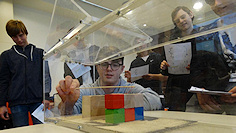Přijďte k nám ve dnech 12., 14. a 16. listopadu 2019, ať vidíte, na čem děláme! Více zde.

The presented concept deals with production of entropy generated by the nonequilibrium processes in consequence of the mass and energy transfer. Often used concept of endoreversible thermodynamics is based on non-realistic conjecture that the entire entropy production is realized at the system boundary. In this contribution, the open system in the thermodynamically non-equilibrium state is assumed. Production of entropy is generated due to the non-equilibrium processes accompanied by the energy conversion. The non-equilibrium steady state is maintained by a negative entropy flux. The stability conditions of the state with the minimum of entropy production are used to replace the endoreversibility concept.
This theory is applied to three different open non-equilibrium systems:
i) Efficiency of thermal machines and chemical reactors.
Hydrogen fuel cell with polymer electrolyte membrane are studied in details. The transport coefficients for reactants inlet, i.e. hydrogen and air, and for the products outlet, i.e. water, are connected with the actual electric efficiency. The calculated efficiency qualitatively and quantitatively corresponds to the experimentally obtained values. The further research shall focus on the relation of the parameters characterizing the membrane and transport of reactants and products to the power output.
ii) Energetic limitations of population growth.
Entropy production is characterized by general form of chemical reaction based on the mass action law. This law is usable for description of dynamics of population biology, e.g. cells, species. Moreover, this law can be even used to study dynamics of ecological systems. The reproduction process is spontaneous process with increase of entropy. The entropy increase is compensated by the negative entropy flux from the Sun. From the thermodynamic point of view, the sex reproduction is more advantageous as the cellular division because of it is reached by the lower Gibbs free enthalpy. This is probably the reason why sex reproduction is evolutionarily more advantageous.
iii) Dynamics of ecological system with migration.
Influence of reproduction and migration dynamics is evident on example of two competitive ecological systems (in general two auto catalytic reactions) of type predator and prey. The migration decreases the frequency of dynamical state of system. Due the migration this dynamical state can change to the stationary state, when time period is high enough. In principle, it is a diffusion reaction system in which a stationary spatial change of concentrations can occur. An example may be the presence of colored stripes on the body of some animals, such as cats, some fish, hornets, and the like.
First part of the presentation will explain the pressure distributions over the wetted surfaces of a parabolic contour in 2D and an elliptic paraboloid in 3D for oblique water impact. The pressures are calculated by the Wagner model of water entry with focus on zones of the wetted surface, where the hydrodynamic pressure is below the ambient pressure, and the zones, where the pressure approaches the vapour pressure. When the zones of low hydrodynamic pressure approach the contact line of the body surface, the surrounding air flows into this area separating the liquid surface from the body and leading to ventilation. Several models of ventilation and cavitation for 2D problem of oblique impact of rigid and elastic plates will be introduced. The nonlinear 2D problem of oblique impact of an elliptic cylinder onto a thin liquid layer with multiple bouncing of the cylinder from water will be presented. The second part of the presentation is about the water exit problems including the problem of an elastic disc lifted from water surface. The corresponding exit models will be applied to the 3D problem of a rigid ellipsoid gliding on water surface. Comparison of the obtained results with 3D CFD results will be shown. Our exit model of elastic bodies will be compared with the experimental results for large accelerations of the body lifting.
In this talk, we will discuss about classical and new numerical techniques used for parallel/partitioned computations in structural mechanics and also multi-physics or coupled-field problems. In this field, methods based on classical Lagrange multipliers, like the two-level FETI-DP method, have been de facto the preferred parallel algorithms in solid and structural mechanics for decades. However, as we will see, classical Lagrange multipliers also present some limitations. The method of localized Lagrange multipliers (LLM) is a more general coupling technique, that introduces an explicit definition of the problem interface and brings some important advantages. Under this LLM framework, new partitioned algorithms like AFETI-C method are derived from variational principles. AFETI-C uses a combination of rigid-body modes and dominant substructural deformation modes in enforcing the interface force equilibrium equation as constraint conditions. In addition, a regularization of heterogeneities of partitioned systems is appended to AFETI-C that makes it competitive with FETI-DP. These methods, their derivation and their performance will be described, providing a full understanding of the potential of LLM in the solution of coupled problems.